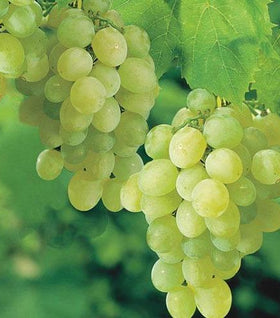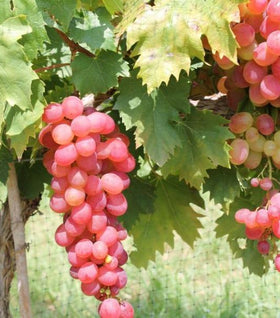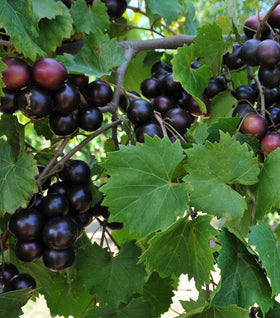Grape Vines for Sale Online
What could be more rewarding than planting fruit vines in your garden and producing delicious and healthy fruits you can eat? For thousands of years, man has been fascinated with the production of grapes. Today's Grape varieties are cold, hardy, heavy producers and bear fruit for up to 50 years! Grapevines are very popular for home fruit growers throughout the U.S. because they are so easy to grow across most hardiness zones.
Things to Consider Before Planting Grapes
Grape plants produce the most fruit when planted in a sunny location with well-drained, fertile soil. They require six to eight hours of sunlight per day. Well-drained soil is important to keep your plants happy. If your soil has a high clay content, incorporate locally sourced compost or add one-third peat to the soil when planting.
Choosing the Best Location for your Grape Vines
When deciding on a location for growing Grapes, there are three main things to consider: Sun, Soil, and Support.
Sun: Grapes thrive and produce the most fruit when planted in an area that receives full sun. Full sun is defined as 6 to 8 hours of un-blocked sunlight during the growing season. Sun is vital for the vines to produce good quality fruit.
Full sun also helps to reduce the instance of disease on grapes leaves. Fruits grown in less than the full sun can develop spots or other types of fungus on the leaves.
Soil: Grape Vines, as with most fruits, will thrive in just about any soil; however, they will not grow in an area that remains wet for extended periods of time. If you live in a place where the soil comprises heavy clay, it is recommended that you amend your soil with locally sourced compost to "lighten" the soil, which will help keep the roots of the tree healthy. Healthy roots are the key to a healthy grape.
If you're not sure of your soil's overall quality, contact your local extension office, and they can help you sample and test your soil.
Support: During the second year, begin training the grapevine on permanent supports such as a trellis or wire structure. Make sure this trellis support is strong enough to support the weight of heavy bunches of grapes. Select the best side canes to form the “double T” shape on the trellis. This training is the same type used in most vineyards because it’s the most productive. Your crop of grapes will be produced on new growth each year, so it pays to keep old wood to a minimum.
Planting instructions for Grape Plants
After you've chosen the best location for your Vines, there are a few easy steps to follow for planting your plants. Grape Plants can be planted at any time of the year as long as the soil can be worked.
Step 1: Water the Grape Plant thoroughly while it is in the pot. Water until you see the water running out of the bottom of the pot.
Step 2: Dig a hole twice as wide as the pot the vine is growing in. The depth of the hole should be as deep as the root ball but not deeper. After the Grape is planted, you should still be able to see the original nursery soil. Planting the Grapes too deep is the leading cause of poor growth and death of newly planted trees.
Step 3: If your existing soil is of low quality, you should amend the soil with local compost or peat moss at a 50/50 rate. This is also the time to mix in an organic starter fertilizer such as Bio-tone by Espoma.
Step 4: Place the Grape Plant in the prepared hole, careful not to overly disturb the roots. It is ok to fluff the roots if the plant is rootbound. This will cause the plant's roots to begin to grow out and down rather than circle the root ball.
Step 5: Begin back-filling with the amended soil in 3 to 4-inch layers being careful to tamp the soil between layers. This will remove air pockets and voids created by larger chunks of soil. Be cautious not to damage the existing roots of the Vine during this process.
Step 6: Use the leftover soil to create a 3 to 4-inch rim around the planting hole's edges. This will allow water to pool around the newly planted vine and slowly seep into the root zone. Proper watering is essential to the survival of the Grape Vine.
We also recommended mulching the newly planted Grape Vines. This helps prevent the sun from drying out the soil and damage the plant's base from mowing equipment such as string-trimmers.
Watering Grape Vines
After you have planted your Grapes, they should be watered about every 2 to 3 days for the first 4 weeks. After that, begin to cut back on the watering frequency but not the amount of water. When watering, be sure to soak the entire root system. Remember that the root system is usually 12 to 16 inches deep on newly planted vines, and water should absorb all the way through the bottom.
Fertilizing Grape Vines
At planting, We recommend adding Bio-tone Starter Fertilizer to the planting hole. Use according to the package instructions. Bio-tone is organic and will not burn the delicate new roots.
Once the Grapes are established, fertilize in the early spring when new growth begins to emerge and again about 6 weeks later. Do not fertilize past mid-summer as fertilizing too late in the season will promote tender growth susceptible to damage from an early frost or freeze.



